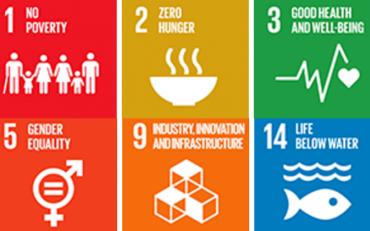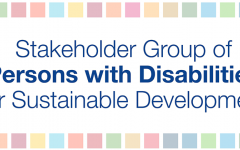The realization of the Sustainable Development Goals is going to be measured through the Global Indicator Framework. The Global Indicator Framework recommends that data gathered through indicators should in relevant cases be disaggregated by disability. IDA and IDDC, in consultation with UN agencies, identified 32 critically important indicators which should be disaggregated by disability in order to gain data on the situation of persons with disabilities worldwide. To create effective and meaningful policies that guarantee the rights of persons with disabilities it is critical to carry out such disaggregation.
As such we have compiled a short document (attached) in which we are calling on Member States to carry out their responsibility to collect and disaggregate data in line with the 2030 Agenda for Sustainable Development and the UN Convention on the Rights of Persons with Disabilities (CRPD) by using the Short Set of Questions developed by the Washington Group.
If you agree and would like to support our advocacy efforts, we are calling for endorsement of this priority indicator list and short statement attached to this email. In order to endorse simply reply to this email. All are invited to endorse, individuals, DPOs, NGOs, and so forth.(No logo nor handwritten scanned signature is needed.)
Thank you!
Explanation:
Indicators measure important characteristics of people and populations, such as the poverty rate in a particular country. When we disaggregate, for example, we find not only the overall proportion of people in a country living below the poverty line, but also the proportion of persons with disabilities who are living below the line.
The request is that all the indicators listed below should be disaggregated by disability.
Priority Indicators listed
Goal 1. End poverty in all its forms everywhere
1.1.1 Proportion of population below the international poverty line, by sex, age, employment status and geographical location (urban/rural)
1.2.1 Proportion of population living below the national poverty line, by sex and age
1.3.1 Proportion of population covered by social protection floors/systems, by sex, distinguishing children, unemployed persons, older persons, persons with disabilities, pregnant women, newborns, work-injury victims and the poor and the vulnerable
Goal 3. Ensure healthy lives and promote well-being for all at all ages
3.3.1 Number of new HIV infections per 1,000 uninfected population, by sex, age and key populations
3.8.1 Coverage of essential health services (defined as the average coverage of essential services based on tracer interventions that include reproductive, maternal, newborn and child health, infectious diseases, non-communicable diseases and service capacity and access, among the general and the most disadvantaged population)
3.8.2 Proportion of population with large household expenditures on health as a share of total household expenditure or income
Goal 4.. Ensure inclusive and equitable quality education and promote lifelong learning opportunities for all
4.1.1 Proportion of children and young people: (a) in grades 2/3; (b) at the end of primary; and (c) at the end of lower secondary achieving at least a minimum proficiency level in (i) reading and (ii) mathematics, by sex
4.2.2 Participation rate in organized learning (one year before the official primary entry age), by sex
4.3.1 Participation rate of youth and adults in formal and non-formal education and training in the previous 12 months, by sex
4.4.1 Proportion of youth and adults with information and communications technology (ICT) skills, by type of skill
4.5.1 Parity indices (female/male, rural/urban, bottom/top wealth quintile and others such as disability status, indigenous peoples and conflict-affected, as data become available) for all education indicators on this list that can be disaggregated
4.6.1 Proportion of population in a given age group achieving at least a fixed level of proficiency in functional (a) literacy and (b) numeracy skills, by sex
4.a.1 Proportion of schools with access to: (a) electricity; (b) the Internet for pedagogical purposes; (c) computers for pedagogical purposes; (d) adapted infrastructure and materials for students with disabilities; (e) basic drinking water; (f) single-sex basic sanitation facilities; and (g) basic handwashing facilities (as per the WASH indicator definitions)
Goal 5. Achieve gender equality and empower all women and girls
5.2.1 Proportion of ever-partnered women and girls aged 15 years and older subjected to physical, sexual or psychological violence by a current or former intimate partner in the previous 12 months, by form of violence and by age
5.2.2 Proportion of women and girls aged 15 years and older subjected to sexual violence by persons other than an intimate partner in the previous 12 months, by age and place of occurrence
5.6.1 Proportion of women aged 15-49 years who make their own informed decisions regarding sexual relations, contraceptive use and reproductive health care
Goal 8. Promote sustained, inclusive and sustainable economic growth, full and productive employment and decent work for all
8.5.1 Average hourly earnings of female and male employees, by occupation, age and persons with disabilities
8.5.2 Unemployment rate, by sex, age and persons with disabilities
Goal 10. Reduce inequality within and among countries
10.2.1 Proportion of people living below 50 per cent of median income, by sex, age and persons with disabilities
10.3.1 Proportion of population reporting having personally felt discriminated against or harassed in the previous 12 months on the basis of a ground of discrimination prohibited under international human rights law
Goal 11. Make cities and human settlements inclusive, safe, resilient and sustainable
11.2.1 Proportion of population that has convenient access to public transport, by sex, age and persons with disabilities
11.7.1 Average share of the built-up area of cities that is open space for public use for all, by sex, age and persons with disabilities
11.7.2 Proportion of persons victim of physical or sexual harassment, by sex, age, disability status and place of occurrence, in the previous 12 months
Goal 16. Promote peaceful and inclusive societies for sustainable development, provide access to justice for all and build effective, accountable and inclusive institutions at all levels
16.1.3 Proportion of population subjected to physical, psychological or sexual violence in the previous 12 months
16.1.4 Proportion of population that feel safe walking alone around the area they live
16.2.1 Proportion of children aged 1-17 years who experienced any physical punishment and/or psychological aggression by caregivers in the past month
16.2.3 Proportion of young women and men aged 18‑29 years who experienced sexual violence by age 18
16.7.1 Proportions of positions (by sex, age, persons with disabilities and population groups) in public institutions (national and local legislatures, public service, and judiciary) compared to national distributions
16.7.2 Proportion of population who believe decision-making is inclusive and responsive, by sex, age, disability and population group
16.b.1 Proportion of population reporting having personally felt discriminated against or harassed in the previous 12 months on the basis of a ground of discrimination prohibited under international human rights law
16.9.1: Proportion of children under 5 years of age whose births have been registered with a civil authority, by age
Goal 17. Strengthen the means of implementation and revitalize the Global Partnership for Sustainable Development
17.8.1 Proportion of individuals using the Internet
OFFICIAL SUBMISSION: Click here






